
Belshazzar's Feast is a circa 1660-1665 oil on canvas painting by Mattia Preti, now in the Museo nazionale di Capodimonte in Naples. [1] It shows a scene from chapter 5 of the Book of Daniel. [1]

Belshazzar's Feast is a circa 1660-1665 oil on canvas painting by Mattia Preti, now in the Museo nazionale di Capodimonte in Naples. [1] It shows a scene from chapter 5 of the Book of Daniel. [1]
Banquets were a common motif in Preti's later work, having seen Peter Paul Rubens' The Feast of Herod in the Roomer collection in Naples and then in the Vandeneynden collection. The painting was first mentioned in the historical record by Bernardo De Dominici, who saw it in the Sanseverino family collection in Naples alongside other works by Preti such as The Banquet of Absalom (now also in the Museo de Capodimonte) and David Playing His Harp Before Saul (now in a private collection in New York). [2] It was then recorded after 1745 in the Colonna di Stigliano family collection, [2] probably after being in the Vandeneynden collection, which was merged into the Colonna di Stigliano collection when Ferdinand van den Eynde's daughter Giovanna married Giuliano Colonna of Stigliano in 1688 (she also inherited Palazzo Zevallos from her father, renamed Palazzo Colonna di Stigliano after her marriage). The Italian state bought it and Absalom from Cecilia Colonna di Stigliano (granddaughter of Andrea Colonna di Stigliano, 1st Prince of Stigliano, himself grandson of Ferdinando Colonna of Stigliano, 2nd Prince of Sonnino, son of Giovanna Vandeneynden) and placed them both in their current home. [2]

Mattia Preti was an Italian Baroque artist who worked in Italy and Malta. He was appointed a Member of the Order of Saint John.
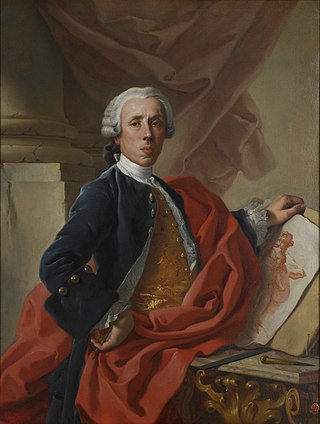
Francesco de Mura was an Italian painter of the late-Baroque period, active mainly in Naples and Turin. His late work reflects the style of neoclassicism.

The Palazzo Zevallos Stigliano is a Baroque palace located on Via Toledo number 185 in the quartiere San Ferdinando of central Naples, Italy. It is also called the Palazzo Zevallos or Palazzo Colonna di Stigliano, and since 2014 serves as a museum of artworks, mainly spanning the 17th through the early 20th centuries, sponsored by the Cultural Project of the bank Intesa Sanpaolo. This museum is linked to the Museum or Gallerie di Piazza Scala in Milan and the Museum at Palazzo Leoni Montanari in Vicenza, also owned by the Bank.

The Banquet of a Rich Glutton is an oil on canvas painting by the Italian Baroque painter Mattia Preti, executed c. 1665. It is housed in the Pinacoteca of the Galleria Nazionale d'Arte Antica, in Rome.

Saint Sebastian is an oil on canvas painting by Italian artist Mattia Preti, created c. 1657. It represents Saint Sebastian, and is held in the National Museum of Capodimonte, in Naples.

Jan van den Eynde or Vandeneynden was a prominent Netherlandish merchant, banker, art collector, and patron of the arts. He was brother to Flemish merchant, art collector and art dealer Ferdinand van den Eynde, and father of the latter's namesake Ferdinand van den Eynde, Marquess of Castelnuovo. Van den Eynde's granddaughters were Elisabeth van den Eynde, Princess of Belvedere and Baroness of Gallicchio and Missanello, and Jane (Giovanna) van den Eynde, Princess of Galatro and Sonnino.
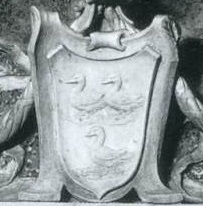
Ferdinand van den Eynde, 1st Marquess of Castelnuovo was an Italian nobleman and magnate of Flemish descent. He was the son of Jan van den Eynde, and the father of Elisabeth van den Eynde, Princess of Belvedere and Baroness of Gallicchio and Missanello and Jane (Giovanna) van den Eynde, Princess of Galatro and Sonnino. He should not be confused with his namesake and uncle Ferdinand van den Eynde.

Princess Giovanna van den Eynde was a member of the Van den Eynde family, Marchioness of Castelnuovo by birth, and the Princess consort of Galatro and Sonnino. She was the daughter of Ferdinand van den Eynde, 1st Marquess of Castelnuovo, son of the magnate Jan van den Eynde, and Olimpia Piccolomini, of the House of Piccolomini. Through her marriage to Giuliano Colonna, Giovanna became a member of the House of Colonna, and the first Princess of Sonnino. Through his marriage to her, Giovanna's husband acquired the title of Marquess of Castelnuovo.

Elisabeth van den Eynde, Princess of Belvedere and suo jure Baroness of Gallicchio and Missanello was an Italian noblewoman. She was the consort of Carlo Carafa, 3rd Prince of Belvedere, 6th Marquess of Anzi, and Lord of Trivigno, and the daughter of Ferdinand van den Eynde, 1st Marquess of Castelnuovo and Olimpia Piccolomini, of the House of Piccolomini. Her grandfather was Jan van den Eynde, a wealthy Flemish merchant, banker and art collector who purchased and renovated the Palazzo Zevallos Stigliano in 1653. Her father Ferdinand, the Marquess of Castelnuovo, built the Vandeneynden Palace of Belvedere between 1671 and 1673. While the Palazzo Zevallos in central Naples passed to her elder sister Giovanna, who married a Colonna heir, Elisabeth was given the monumental Palazzo Vandeneynden, alongside a smaller portion of the Marquess' assets, which included his art collection, one of the largest and most valuable in Naples and its surroundings. Upon her marriage to Carlo Carafa, the Vandeneynden Palace came to be known as Villa Carafa.

Giuliano Colonna, 1st Prince o Sonnino was an Italian nobleman of the House of Colonna. He was Prince of Galatro and Sonnino, and a Grandee of Spain. In 1688 he married the great heiress Giovanna van den Eynde, from whom he acquired a fortune, the title of Marquess of Castelnuovo, and the Palazzo Zevallos Stigliano.
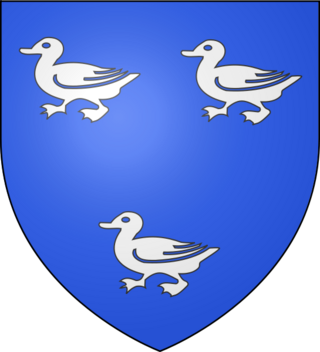
Marquess of Castelnuovo was a title in the Neapolitan nobility, at the time part of the Spanish peerage, that was created in the late 17th century for Ferdinand van den Eynde, 1st Marquess of Castelnuovo. The marquessate was purchased by the Flemish magnate Jan van den Eynde, at the time one of the wealthiest men in the city of Naples, for his son Ferdinand. Ferdinand married Olimpia Piccolomini, of the House of Piccolomini, by whom he had three daughters. Thanks to the marriage of his heir apparent Giovanna to Giuliano Colonna, the title was inherited by Giovanna's son, Ferdinando Colonna. The title was held for nine generations by the Colonna, before losing statutory regulation and lawful recognition upon the establishment of the Italian Republic, wherein aristocratic titles are neither recognized nor protected, peerage titles having "no value whatsoever" outside that of any other sobriquet.
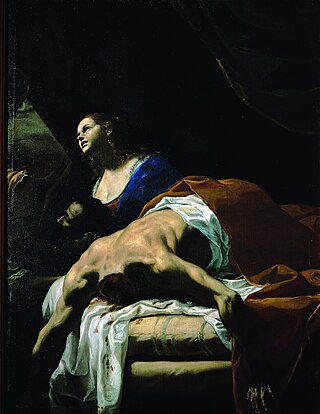
Judith and Holofernes is an oil on canvas painting by Italian artist Mattia Preti, datable to around 1653–1656. It is held at the Museo di Capodimonte, in Naples.

Madonna of Constantinople is a c. 1656 oil on canvas painting by Mattia Preti. It was the first of many works commissioned as ex-votos for freeing the city from the plague of 1656 – they all showed the Madonna with a selection of the city's patron saints, in this case Joseph, Januarius, Roch, Nicasius and Rosalia (centre). It now hangs in the Museo nazionale di Capodimonte in Naples.

Portrait of Pope Paul III with Camauro is a 1545 – 1546 oil on canvas painting by Titian, now in the Museo nazionale di Capodimonte in Naples.

The Earthly Trinity with Saints and God the Father are a pair of c.1626-c.1635 oil on canvas paintings by Jusepe de Ribera, both now in the Museo nazionale di Capodimonte in Naples. Along with the Holy Family, the main work shows Bruno of Cologne, Benedict of Nursia, Bernardino of Siena and Bonaventure.

Saint John the Baptist is a c.1653-1656 oil on canvas painting by Mattia Preti, now in the Museo nazionale di Capodimonte in Naples.
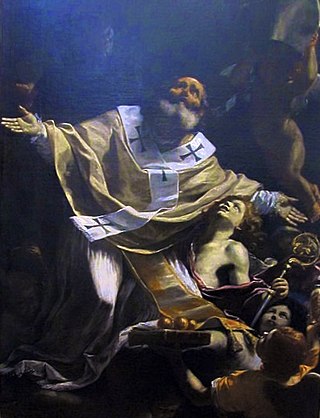
Saint Nicholas is a c. 1653 painting by Mattia Preti, the first work he produced after moving to Naples and showing the three gold balls which are a traditional attribute of the saint. It is now in the Museo nazionale di Capodimonte in the same city. He also produced a larger version of the work in 1657 which is now in the Pinacoteca civica in Fano, with an early copy after the Capodimonte version now in the church of Santa Teresa degli Scalzi in Naples.

The Banquet of Absalom is an oil on canvas painting by Mattia Preti, created in c. 1660–1665, now in the Museo nazionale di Capodimonte in Naples. It illustrates a passage from chapters 13 and 14 of 2 Samuel in the Old Testament, in which King David's son Absalom avenges the rape of Absalom's sister Tamar two years earlier by inviting her rapist Amnon to a feast, getting him drunk and then killing him.

The Return of the Prodigal Son is a 1656 oil on canvas painting by Mattia Preti, now in the Museo nazionale di Capodimonte in Naples.

The Return of the Prodigal Son is a c. 1658 oil on canvas painting by Mattia Preti, now in the Royal Palace of Naples.